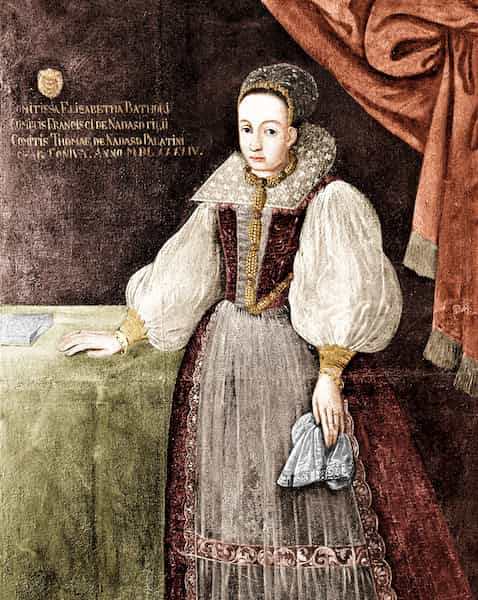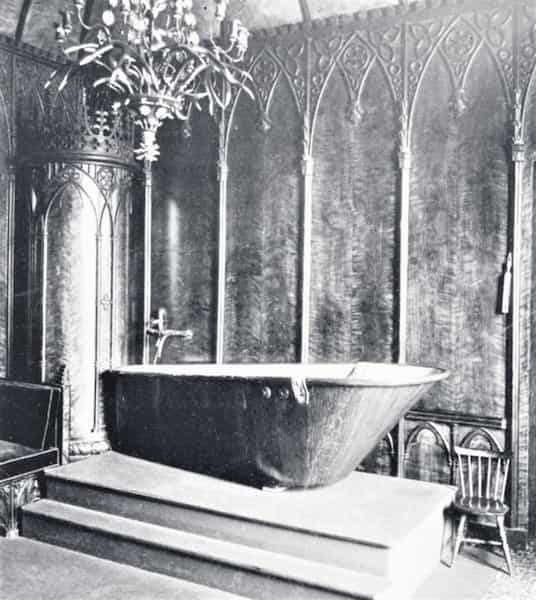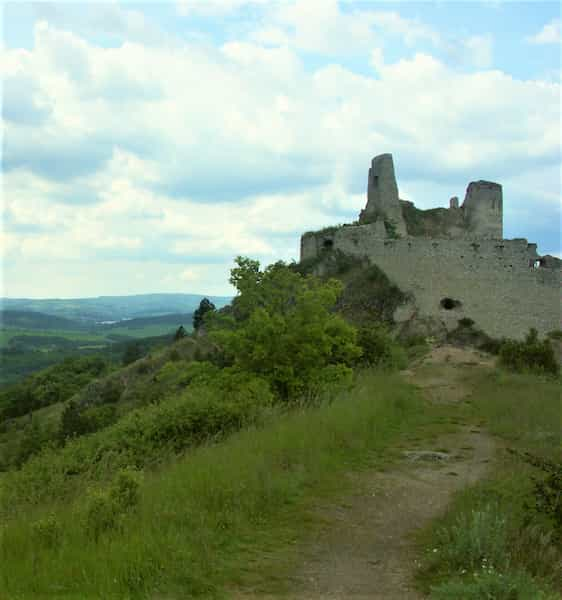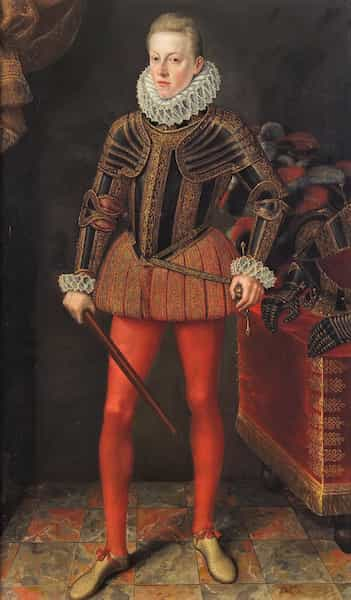Is Čachtice Castle haunted?
The evidence of paranormal activity in Čachtice Castle is poor. The castle was once the home of Elizabeth Báthory, also known as the Blood Countess. Even so, there really isn’t much pointing to Čachtice Castle as being anything else than a very interesting ruin with a dark history.

Who was Elizabeth Bàthory?
She lived between 1560 and 1614 and is regarded as the most prolific female murderer ever. According to Guinness World Records, she has the absolute record in killings by a female assassin with more than 300 victims. Some claim as much as over 600 but that is probably an exaggeration. All these figures are uncertain, and the accurate number of victims can’t be determined.
In 1611 she was sentenced to imprisonment for having killed a tortured hundreds of young girls. The motive was none other than conceit, vanity, and a remarkable indifference to others’ sufferings.
Bram Stoker’s novel Dracula could partly have been inspired by Elizabeth Bàthory’s fate.
Elizabeth Bàthory‘s background.
Elizabeth Bathory was born on August 7, 1560, in Nyrbátor, Hungary.
She had a good education, she was intelligent and good-looking. And as she also was from the wealthy and powerful noble family Bathory, very soon a match was found for her. Already at the age of 10, she was engaged to be married to Count Ferenc Nadasdy, at the time, 15. They married in 1575 when she was 15 and he was 20. Čachtice Castle, or Castle of Csejte as it is also called, was her wedding gift.
Their marriage was functional; Ferenc was mostly away from home fighting the Turks, and Elizabeth was running the estates… Čachtice Castle, and many others over a vast territory. Being a Dutchess with that much responsibility required a steady hand, authority, and a great deal of knowledge about all kinds of things. She seems to have had all these attributes.
Together they had five children of whom three survived to adulthood.
A young widow.
However, in 1604 Ferenc Nadasdy died from a mysterious disease. And now Elizabeth Bathory was alone. Maybe the husband, a national hero, had in some way set up a calming barrier for his wife. And now that it was gone, the woman felt no boundaries, no restrain to the violence that boiled in her blood.
From 1604 she was also more vulnerable. The Turks still threatened her lands, and without her husband, she lost many of the allegiances among the surrounding noble houses, and the court, as well as a steady income…
Čachtice Castle – How the Blood Rites started.
It is said that it all started with the blood of a housemaid. When combing the Dutchess’ hair she involuntarily pulled too hard and it tugged on a snag. Elizabeth got so angry that she hit the girl with the back of her hand with such force that the maid started bleeding and some of her blood was left on the Dutchess’ hand. Later Elizabeth noticed a softness in that particular spot. So, she logically concluded:
– If a few drops of blood can create such sweet youth on my hand… What if I could cover my whole body with blood from young women…
Legend has it that she killed the girls, drained them of their blood, and then used it as a youth elixir, bathing in it. As many as 600 young girls, aged 10 to 14 years, could have been killed to preserve the soft skin of Elizabeth Bathory. And the atrocities intensified after Nadasdy died, although some historians claim that Ferenc was participating in the murders, and maybe even taught Elizabeth something about torture techniques.
Killing the daughters of nobles as well.
In the beginning, the victims were servants, maids, and other local and poor girls. Soon people were getting suspicious though, and they weren’t so keen on sending their daughters to the castle. So Elizabeth started taking in girls from the Hungarian lower nobilities for education, tutoring in courtly etiquette. This was a bit more delicate as they came from richer families. But as they lived together with her and their relatives often lived at a distance from Čachtice Castle, the killings could continue.
With time the rumors spread and even before Ferenc Nadasdy died, the court in Vienna was aware that something was very off with the Dutchess Bathory and the Čachtice Castle. And although she was protected by her name, rank, and at least until 1604 by her husband, the authorities were catching up on her.
She probably got somewhat careless with time. She found that her untouchable position and protective rank prevented her from being confronted and accused of having done something wrong. Incredible as it may seem, beating servants was a common way to negotiate working conditions back then. And that an employee died, was sometimes seen as just an inconvenience. She possibly thought she was above the law.
The arrest of Elizabeth Báthory.
On the evening of December 27, 1610, Prince Thurzo together with his men arrived at Čachtice Castle. They entered and ordered the servants to stand aside. As the party burst into the courtyard they immediately came upon the bloody, battered, and still warm corpse of a young girl with no clothes and seemingly thrown by a doorway without any efforts made to hide or cover the body.
When Ferenc Nadasdy died, George Thurzo who was a relative to Elizabeth Bathory by marriage was entrusted as the heir. In those days, a woman couldn’t hold property. In 1610 George Thurzo was ordered by the parliament in Bratislava to arrest Elizabeth Bathory and bring her to justice. Complaints had been made with increasing frequency. And the new King Matthias, who had been in power since 1608, wanted a solution to the flammable situation in western Hungary.
As Thurzo’s men searched the premises, the bodies of two more brutally murdered girls were found inside the manor house. When entering the tower, a stench revealed numerous identically tortured, killed, and now decaying bodies in the lower dungeons.
Elizabeth Bathory was immediately arrested but left in the Čachtice Castle. Four of her servants, A boy named János Újváry, An elderly wet-nurse, Ilona Jó Nagy; her friend Dorottya Szentes; and an old washerwoman, Katalin Beneczky, were all brought to Thurzo’s residence in Bytca for questioning.
The Trial
The four servants were cross-examined separately supposedly under torture. Then their separate testimonies were scrutinized for inconsistencies. They all claimed they could not oppose the Countess, and that they were innocent. Still, they were sentenced to death in three cases. Two were to have their fingers torn away and then be burnt alive. One was to be decapitated and then burnt. The fourth servant doesn’t appear in the documented sentences.
Elizabeth Bathory appeared in Thurzo’s private court on January 2, 1611. The testimonies were overwhelming, very much thanks to a young priest, Reverend Janos Ponikenusz, who was appointed to the church of Cachtice. Much like the young solicitor Jonathan Flynn Harker in Bram Stoker’s novel, Dracula, Reverent Janos was horrified by the stories he was told by the peasants when he first came to the village. They narrated of Vampires and unholy beings in the Čachtice Castle… And they told him of the young girls who disappeared after having taken service with the Countess. Reverent Janos produced hundreds of ordinated, well-articulated testimonies from the villagers, and he largely contributed to the documentation of the case.
The four servants’ testimonies also put weight on the accusing side.
On the evening of the 2nd of January, Elizabeth Bathory was sentenced to life imprisonment in her own castle, for having tortured and murdered 50 young girls.
Five days later a higher court overlooked the sentence, and it is here we find the figure of 650 murdered girls. A testimony, a maid in Čachtice Castle by the name of Zusanna, said that she had found a register in Elizabeth’s chest of drawers listing her victims and that it totaled 650 names. The court confirmed the sentence of life imprisonment.
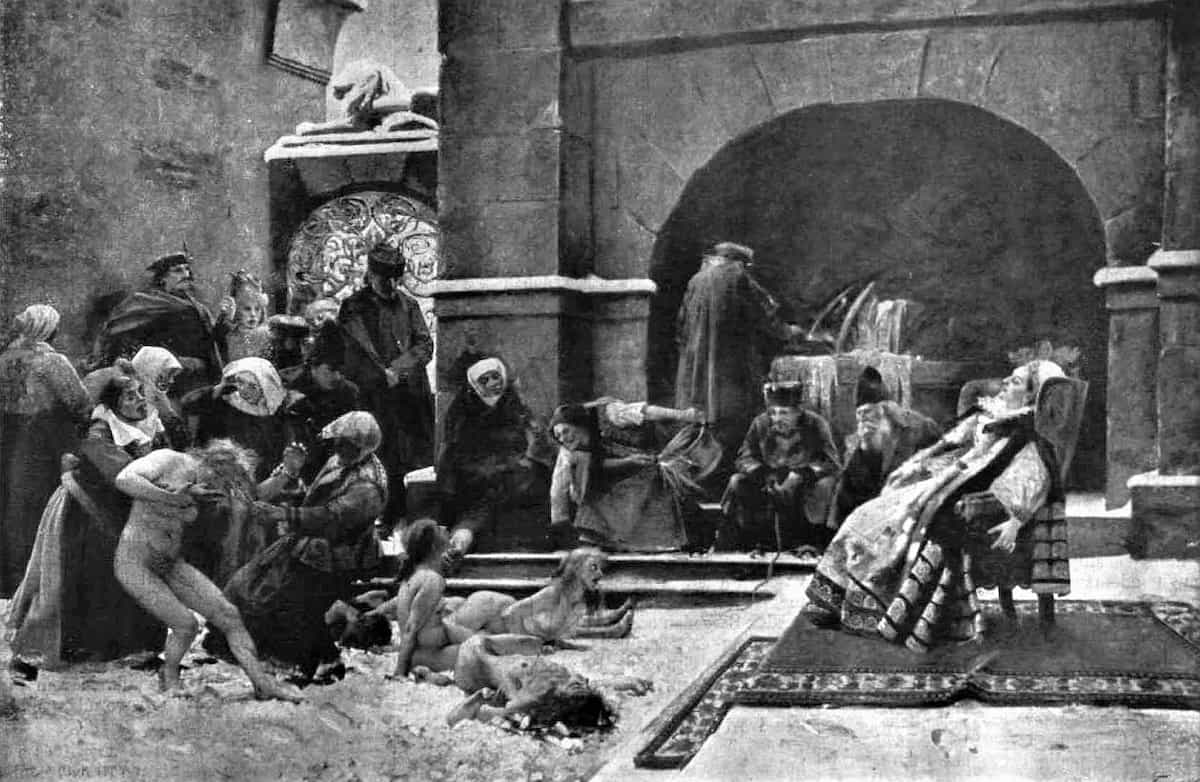 The hauntings… Or not the hauntings
The hauntings… Or not the hauntings
So… Is Čachtice Castle haunted?
What usually happens with old buildings with a dark history, is that they are targeted with tellings and stories. The Čachtice Castle, with its incredibly bloody and violent past, has a strong attraction to anyone with paranormal ambitions. And there have been hundreds of claims of sightings. Mostly of young girls crying, an old lady, or a figure that is interpreted as Elizabeth Bathory herself. This latter ghost appears with her arms stretched out wide as if she wanted to embrace you. She has no face.
As often is the case, the stories are many but the substantial evidence is little or absent. The paranormal experts have very little to weigh in.
A few examples of actual and fictional documentation.
- In 2008 Ghost Hunters International, the TV series spin-off of Ghost Hunters on SciFi visited the Čachtice Castle, only to reach the verdict… Non-haunted.
- The Slovacchia group, Paranormal Project official (PPO), investigated the property in 2018 with no or non-convincing results.
- The Australian blogger Amy of Amy’s Crypt spent the night there in 2018, but not even she found anything significant. Although the Catacombs underneath the Castle are accessible and most of the sightings have occurred there, nothing was documented.
As I see it, Čachtice Castle is another of many historical buildings that because of a troubled and dark history are tied to hauntings and ghosts. But this beautiful ruin in the beautiful, hillside landscape with green grass, trees, lakes, and rivers just doesn’t hold any ghosts or phantoms. It does not seem to be a paranormal site at all.
The Political Background to the atrocities in Čachtice Castle.
The political background is an interesting topic. Because there are quite a few circumstances that could have led to a guilty sentence. There were people with ambitions, and groups with agendas around the Countess at the time. And they all had interest in seeing her put away.
Elizabeth Bathory was raised a Calvinist. And she was a devoted and religious woman all her life. The Kings of the powerful Empire of Austria and Hungary, first Rudolf II, and then Matthias were Roman Catholics. They both held the title Holy Roman Emperor and as such, they pledged allegiance to the Vatican State and the Pope.
King Rudolf was an intellectual who preferred spending his days studying occult arts. But his successor, King Matthias, who was crowned King of Hungary and Croatia, and Archduke of Austria in 1608, and even before that gradually had started taking control of the Empire, was a man of action. He fought, compromised, and withdrew, all to gain political and military advantages.
The Bathory Family was very powerful though. Even the King had to be careful when dealing with one of their kin.
The Inquisition
At the beginning of 1600, we are in the middle of the counter-reformation. The Congregation of the Holy Office was a potent religious section of the Roman Catholic Church, backed up by Cardinals, Bishops, and other officials. They had the power to sentence anybody to death for witchcraft if they so choose.
The Economical Background to the atrocities in Čachtice Castle.
The war with the Turks was expensive for the Empire. The Habsburgs had to spend enormous sums of gold, to keep Europe safe. And Austria, and even more so Hungary, were the first targets of Ottoman aggression. And the wars just kept on coming, causing a strain on the economy.
King Rudolf had expensive taste. All the way up until his death, he collected art pieces, paintings, sculptures, and curiosities of various nature. But he also collected Artists, Scientists, and Alchemists, who were patronized and brought to his castle in Prague. Even an impressive collection of exotic animals roamed the Castle and gardens. All this was consuming large quantities of gold.
In this context, it’s interesting to know that Elizabeth Bathory was extremely wealthy. And not only did she have land, estates, and gold… She also had demands on the King. She and her husband had lent huge amounts of money to the crown, and now when she was alone, and Ferenc Nadasdy was dead and couldn’t bring back loot from the wars, she wanted the King to repay his debts. It’s said that she often traveled to Prague to get her money.
Due to her Family’s reputation and status, Elizabeth considered herself more or less untouchable by common law or political wrath.
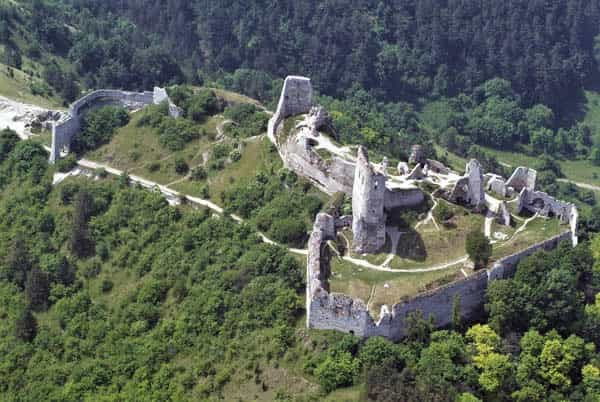
The Trials one more time…
So, let’s consider the facts one by one:
- Elizabeth was arrested on December 27, 1610. (This is in the middle of the holidays…)
- She was trialed on January 2, 1611, only six days afterward. In the meantime (while the celebrations of the new year were continuing…) the servants were cross-examined, the witnesses were gathered and the documentation and all other testimonies were prepared.
- On the evening of that same day, she was sentenced to house arrest for life.
- All this happened in Prince Thurzo’s private court, where all personnel swore loyalty to Thurzo.
- Reverent Janos was a priest of the catholic faith, while Elizabeth was a Protestant; Calvinist.
- No mention of blood as a cure for aging, nor anything about bathing in blood is ever mentioned in the documentation from the trial.
- She was finally sentenced for having tortured and murdered approximately fifty young women.
Historians have concluded that the sentence was a way to keep the wealth within the family, and to not cause damage to the family name from what had come forth about Elizabeth. Thurzo was a relative and a friend of the family. He had to avoid a witch trial or having her sentenced to death at all costs. Because if Elizabeth Bathory was to face a death sentence, for witchcraft or not, all her belongings would fall into the hands of the state, i.e. King Matthias.
In fact, the court on January 7th seems to have been set up for that purpose. To no avail though, as Thurzo managed to convince the court of the correctness of the sentence from the 2nd of January.
The Elizabeth Bathory fate and legacy.

After the trial, she was walled-in inside her castle. The exterior windows were bricked up. Only small openings for air and food were given to her. For four years she dwelled inside the shadows of her beloved citadel. On August 21, 1614, Elizabeth Bathory collapsed on the floor of her dining room. She died shortly after at the age of fifty-four.
A law forbade all mentioning of her name in Hungary for one hundred years and the memory of her soon faded. She became a legend, a myth, a ghost similar to the many Vampire- and monster tales of Transylvania and the eastern parts of Hungary.
And maybe there’s where she slowly became what she is today… The legendary Blood Countess who bathed in the blood of Virgins to conserve her youth and beauty. A female vampire, just as intriguing and fascinating as Count Dracula.
Today Čachtice Castle is a ruin. It is open every day during office hours and can be visited with or without a guide.
The Film Bathory Countess of blood from 2008 by the Slovak film director Juraj Jakubisko is based on the life of the Countess.
Back to the top of the page
Conclusion.
No, Čachtice Castle is not haunted. There are even doubts about how evil and cruel Elizabeth Báthory really was. She was a murderer, but maybe she was also a victim of political, religious, and economical ambition among her opponents.
The extra star is for Čachtice Castle’s extraordinarily spooky history…

sources
- Wikipedia / Elizabeth Báthory
- Sons of Cain / The True Story of Elizabeth Báthory “The Blood Countess”
- Biography / Elizabeth Bathory
- The Life of Erzsebet Bathory
- Infamous Lady / The True Story of Countess Erzsebet Bathory
- syfywire / Countess Elizabeth Bàthory and the dark truth behind her killer legend.
-
Raymond T. McNally / Dracula was a Woman: In Search of the Blood Countess of Transylvania
